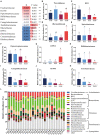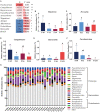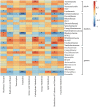Folic Acid Absorption Characteristics and Effect on Cecal Microbiota of Laying Hens
- PMID: 34485442
- PMCID: PMC8416075
- DOI: 10.3389/fvets.2021.720851
Folic Acid Absorption Characteristics and Effect on Cecal Microbiota of Laying Hens
Abstract
This experiment was conducted to investigate the characteristics of folic acid (FA) absorption in laying hens and the effect of FA supplementation on cecal microbiota. A total of 432 healthy hens (30-week-old) were randomly assigned to four diets supplemented with FA: 0, 1, 6, and 24 mg/kg of feed for 8 w. Blood, duodenum, jejunum, ileum, cecum, and cecal chyme samples (six samples per treatment) were collected from the hens at the end of the feeding trial. Expression profiles of folate transport and transformation genes in intestine and cecal microbiota were detected. Results showed that serum folate level significantly increased (P < 0.01) with an increase in dietary FA supplementation, reaching a plateau at 6 mg/kg FA supplementation. The expression of FA transport and transformation genes was not affected in the cecum (P > 0.05) by dietary FA supplementation; however, it was affected in the duodenum, jejunum, and ileum and mostly showed a downward trend in treatment groups (P < 0.05). The genes affected include duodenal folate receptor (Folr) and dihydrofolate reductase (Dhfr), jejunal proton-coupled folate transporter (Pcft) and reduced folate carrier (Rfc), and ileal ATP binding cassette subfamily C member (Abcc2), Abcc3, Rfc, Folr, and Dhfr. Furthermore, according to the operational taxonomic unit classification and taxonomic position identification, the cecal microbiota population of the hens was not affected by dietary FA supplementation at the phylum, class, order, family, genus, and species levels (P > 0.05). However, the relative abundance of some microbiota was affected by dietary FA supplementation (P < 0.05). In conclusion, FA transport from the intestinal lumen into enterocytes, and then into the bloodstream, is strictly regulated, which may be associated with the regulation of the expression profiles of genes involved in FA absorption. Pathogenic bacteria decreased in the cecum, especially at 24 mg/kg supplementation, but the beneficial bacteria (Bifidobacteriaceae) decreased at this level, too. Overall, FA supplementation at 6 mg/kg, which was selected for folate-enriched egg production, did not affect the health and metabolism of laying hens negatively.
Keywords: absorption; folic acid; functional prediction; gut microbiota; laying hen.
Copyright © 2021 Bai, Wang, Yang, Li and Wu.
Conflict of interest statement
The authors declare that the research was conducted in the absence of any commercial or financial relationships that could be construed as a potential conflict of interest.
Figures





References
-
- Sukla KK, Nagar R, Raman R. Vitamin-B12 and folate deficiency, major contributing factors for anemia: a population based study. ESPEN J. (2014) 9:1. 10.1016/j.clnme.2013.11.003 - DOI
LinkOut - more resources
Full Text Sources

